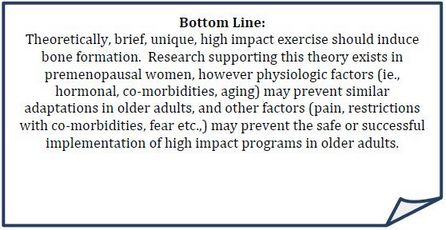Other Research to Consider Copy
The Potential of HIGH IMPACT Programs:
The mechanostat theory16 dictates that bone adaptation is a response system likened to a thermostat in which a set point, or minimum effective strain (MES), is determined by internal & external factors and therefore respond to loads above or below these MES points with either bone formation or resorption. Simply put, load the bone above its natural MES, and it will adapt the bone to support the new demand; conversely, unloading the bone (below its MES) and the BMD will decline to meet its new metabolic environment.
Animal studies have provided information regarding mechanical loading for optimal bone formation:
- Strain from loading must be of high magnitude.
- A high rate of strain provides a greater osteogenic stimulus than same peak strain achieved gradually.
- Bone adaptation is driven by unusual strain distributions and may stimulate an osteogenic response at a lower MES
- Cycles of loading are unimportant beyond a certain threshold30,39,44
Human research of high-impact loading reveals:
- RCTs investigating brief, high-impact exercise in premenopausal women have shown significant improvements of hip and/or spine BMD1,2,28,52,54
- similar programs applied to postmenopausal women do not show any significant trends to improving BMD2

Other POSITIVE EFFECTS of Exercise in OP:
- Exercise reduces the risk of falls and fractures in osteopenic women already at risk24
- A 10-week comprehensive exercise & balance program reduced back pain, improved quality of life and balance33 in post-menopausal women with vertebral fractures
- A 12-week home-based trunk strengthening program enhanced quality of life in postmenopausal osteoporotic & ostepenic women11
- A low-intensity back strengthening exercise program effectively improved quality of life in osteoporotic patients 23
- A recent Cochrane review18 determined that multiple component group exercise, Tai Chi in a group, and individually prescribed multiple component home exercise all reduces the rates of falls and risk of falling.
- If the treatment goal is to prevent falls, a recent systematic review45 indicates that the inclusion of balance retraining in an exercise program is important. Furthermore, the criterion for a minimal effective exercise dose would equate to a twice weekly program over 25 weeks. Lastly, the study revealed that exercise programs which did not include walking were more effective in prevention of falls. Therefore, walking programs should not be relied upon as a means to prevent falls.